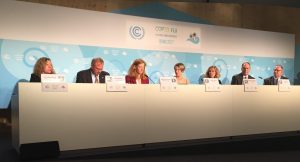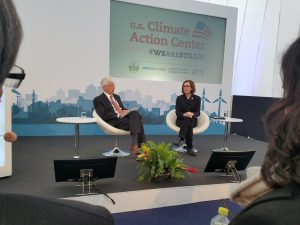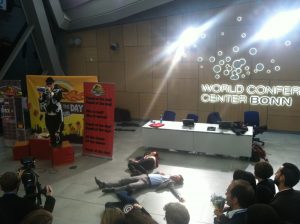Mike
For me, Day 2 of COP23 was Day 1 at the Bula Zone (where the formal UNFCCC negotiations occur, in addition to press and side events). It was interesting to witness the differences between the two Zones: while the Bonn Zone was a lively and colorful–with each country’s pavilion displaying their national pride–the Bula Zone was quiet and a little bit somber. That said, I still enjoyed my time at the Bula Zone, especially helping put on a press conference with my client, BCSE. The press conference was an opportunity for them to announce the release of their position paper, Powering Ambition at COP23. Featured speakers highlighted initiatives their companies are

undertaking to reduce greenhouse gases and increase renewable energy generation. I heard a great statistic from Jeff Moe, Director of Energy Policy and Global Product Advocacy at Ingersoll Rand. He mentioned that they are working to reduce their GHG emissions 50% by 2020, and they’re on track to achieve those goals. To date, they’ve saved 6.7 million tons of CO2e. He also suggested that if their competitors (6-8 companies) followed suit, that would reduce global GHG emissions by 4-8% . That might seem like a small number, but that’s just one industry–and only requires changes by less than 10 companies. That short anecdote reinforced the idea that, if we truly seek greenhouse gas reductions at a large scale, we have to engage the private sector to achieve significant results.
Tim
I spent the entirety of today in the U.S. Climate Action Center. The most notable event I attended was a discussion regarding State and subnational climate leadership in North America. It started with a conversation with Oregon Governor Kate Brown, in which she detailed how her use of executive orders, and the Oregon legislature, have helped to make Oregon a leader in climate action. This was the third time I’ve heard her speak at COP23, and each time she has reiterated that even though the current U.S. administration is rejecting the economy of the future, states are leading the way. She provided numerous details to support her assertion that Oregon is proving that we can tackle global climate change and grow our economy at the same time, and it was inspiring to hear about how a smaller state like Oregon is stepping up to the plate. Governor Brown’s interview was followed by a discussion with several other leaders from U.S. States and Canada, who reiterated her message and details of how sub-national actors in North America are collaborating to solve the challenges presented by climate change while maintaining and expanding their economies. The other sessions I attended in the U.S. Climate Action Center had a similar tone, which makes sense, given the emphasis on U.S. involvement by the United States Climate Alliance. I’ll likely be in the U.S. Climate Action Center for the better part of tomorrow, and I’m interested to see how the messaging by the various groups I hear speak will compare to what the political leaders have had to say.
are leading the way. She provided numerous details to support her assertion that Oregon is proving that we can tackle global climate change and grow our economy at the same time, and it was inspiring to hear about how a smaller state like Oregon is stepping up to the plate. Governor Brown’s interview was followed by a discussion with several other leaders from U.S. States and Canada, who reiterated her message and details of how sub-national actors in North America are collaborating to solve the challenges presented by climate change while maintaining and expanding their economies. The other sessions I attended in the U.S. Climate Action Center had a similar tone, which makes sense, given the emphasis on U.S. involvement by the United States Climate Alliance. I’ll likely be in the U.S. Climate Action Center for the better part of tomorrow, and I’m interested to see how the messaging by the various groups I hear speak will compare to what the political leaders have had to say.
Sarah
Today I attended side events at the Sustainable Innovation Forum, which focused on the interplay between private businesses and government initiatives. The discussions ranged from sustainable planning to green bonds. One of my favorite panels focused on how data can enhance climate policy and solutions, but also comes with its own risks and considerations. Robert Kirkpatrick, Director of Global Pulse from the UN, predicted that big data was like nuclear energy–it will soon be regulated as carefully, because its capacity, while powerful, was also extremely dangerous. I also helped my client at three panels, one at which Governor Kate Brown spoke, another with policy experts from Minnesota, California, British Columbia and Hawaii, and the final panel, in which policy experts from from Colorado, Maryland, Massachusetts and New York discussed how on a regional level they are collaborating to share best practices and develop sustainable policies.
Cathin
I spent most of my day 2 on resilience talks held by Global Climate Action, Marrakech Partnership. The morning event focused on SIDs and other vulnerable countries, that brought high-level representatives from public and private actors to discuss successes in increasing climate resilience of countries. The afternoon one was to discuss the success stories of nature-based solutions. One thing addressed in both talks is financing resilience. The mayor of Beira, Mozambique shared an impressive story in rehabilitating Chiveve river and associated green infrastructure around the city. Audiences and even co-speakers on the stage showed great interest in how he managed to allocate this large amount of fund in environment, while environment was usually not given priority in government spending. Besides that, he also shared experience in how to enforce large environmental engineering project, and persuade people to relocate. While during our study and research we focused more on theoretical experience, those practitioners gave me more insights on the real challenges and solutions that could be encountered in practice.
Shani
I spent my first day at COP 23 getting familiar with the Bonn Zone and what it had to offer. I was really impressed with how organized the COP seems overall and the Bonn Zone specifically. The amount of information available on just about every issue related to Climate Change was amazing. It was also interesting to see some of the issues we discussed in class come out in conversations. At the Pakistan side event, the representative provided a detailed rundown of their national climate action plan, but also expressed to me several times that ‘although they were responsible for Climate Change, they were committed to addressing it’. It was also interesting to stumble on issues not addressed in class like the impact of climate change on the disabled communities and related issues like disaster preparedness.
Laurel
I assisted my client, The Nature Conservancy, stay up to date on the Global Stocktake delegation discussions. The Global Stocktake is the five-yearly review of the climate change actions countries have taken, collectively (not as individual countries) as agreed upon in the Paris Accord. The first global stocktake assessment will be in 2023. Every country is required to participate in this action.
Held in the main chamber of the Bula zone, the G77 country bloc stood in the middle of the room, discussing with each other their position for 30 minutes, while the other countries waited in their seats. This is actually quite common, as the process of informal discussion is much faster than country by country. Once the session officially began, it lasted all but 20 minutes as the Philippines delegate, rep
resenting the G77 bloc of countries, mentioned their suggestions to the text, and the EU, and Solomon islands (representing the Least Developed Countries-LDC bloc) reiterated their support for the document. The Solomon Island representative also thanked the G77 for incorporating the LDCs considerations especially.
This, and other achievements on loss and damage earned the G77 group the “Ray of the Day Award” an informal award the Climate Action Network (CAN) began in Bonn in 1999. This award, given at the end of each day of the negotiations, is given to the entity (usually country) that has helped move the negotiations forward and been especially positive.
This is in contrast to the “Fossil of the Day award” given to the country that has slowed or stalled progress in the negotiations. Australia received this daily award for their ‘sense of disregard’ to loss and damage.
http://www.climatenetwork.org/fossil-of-the-day


Leave a Reply